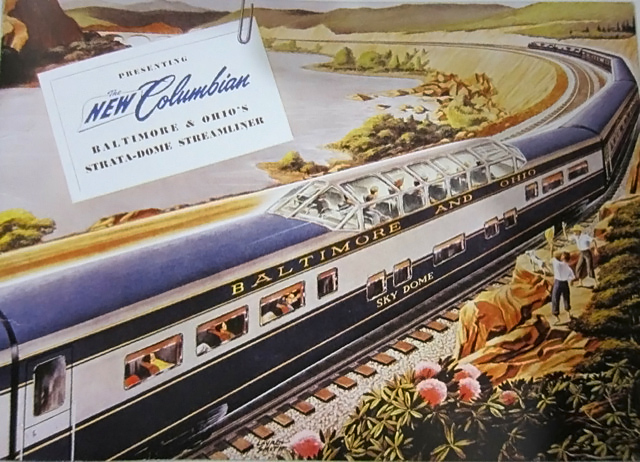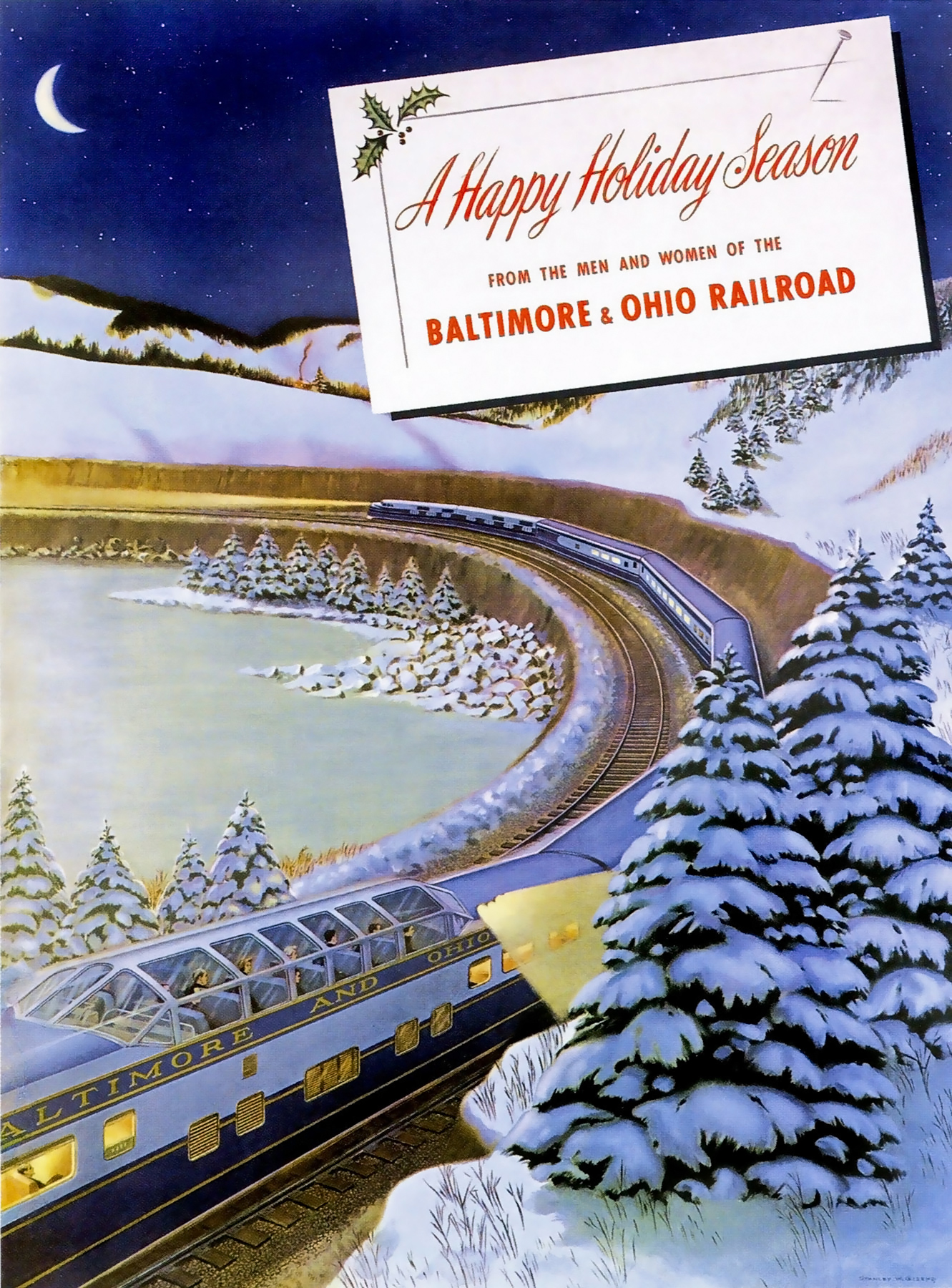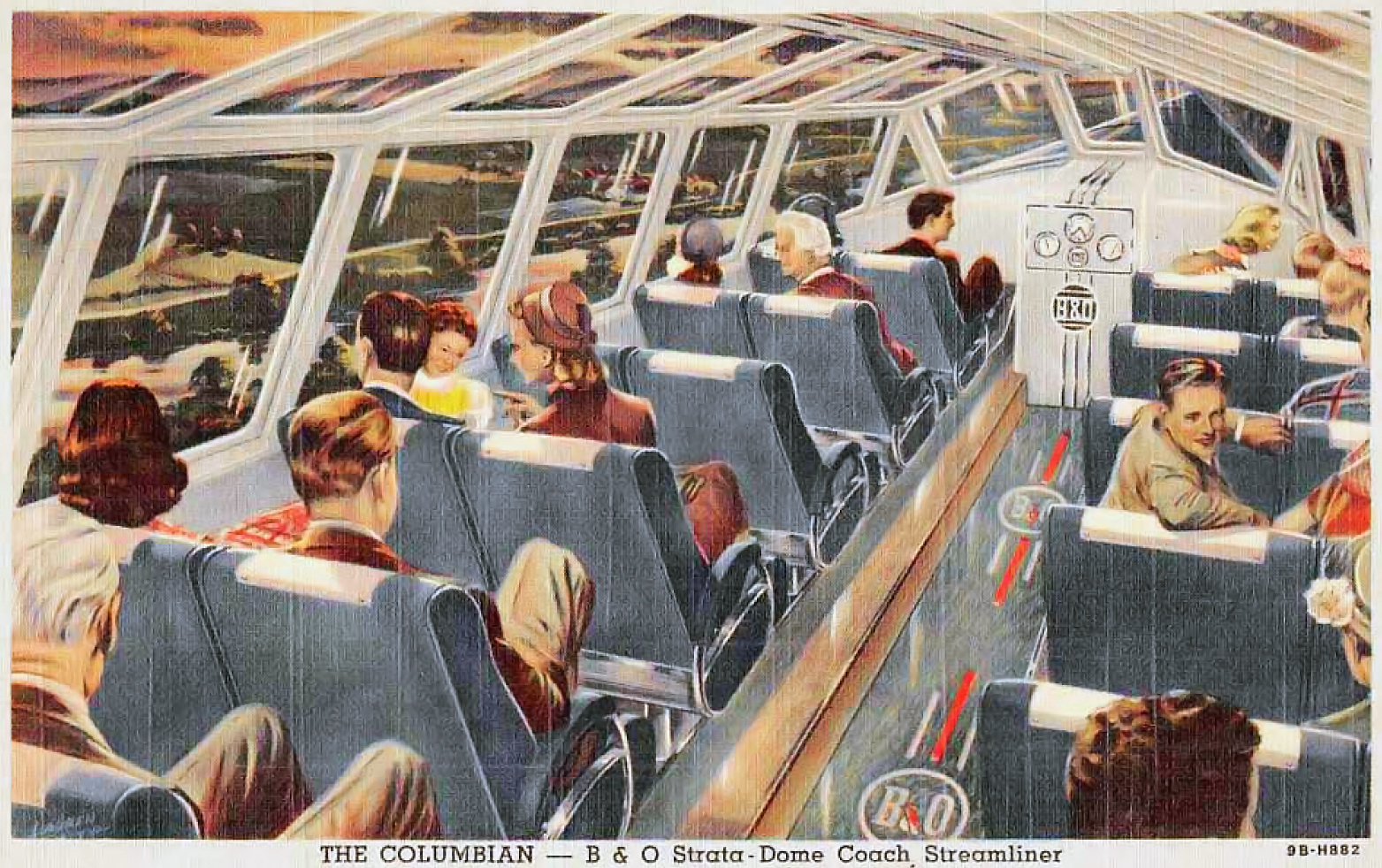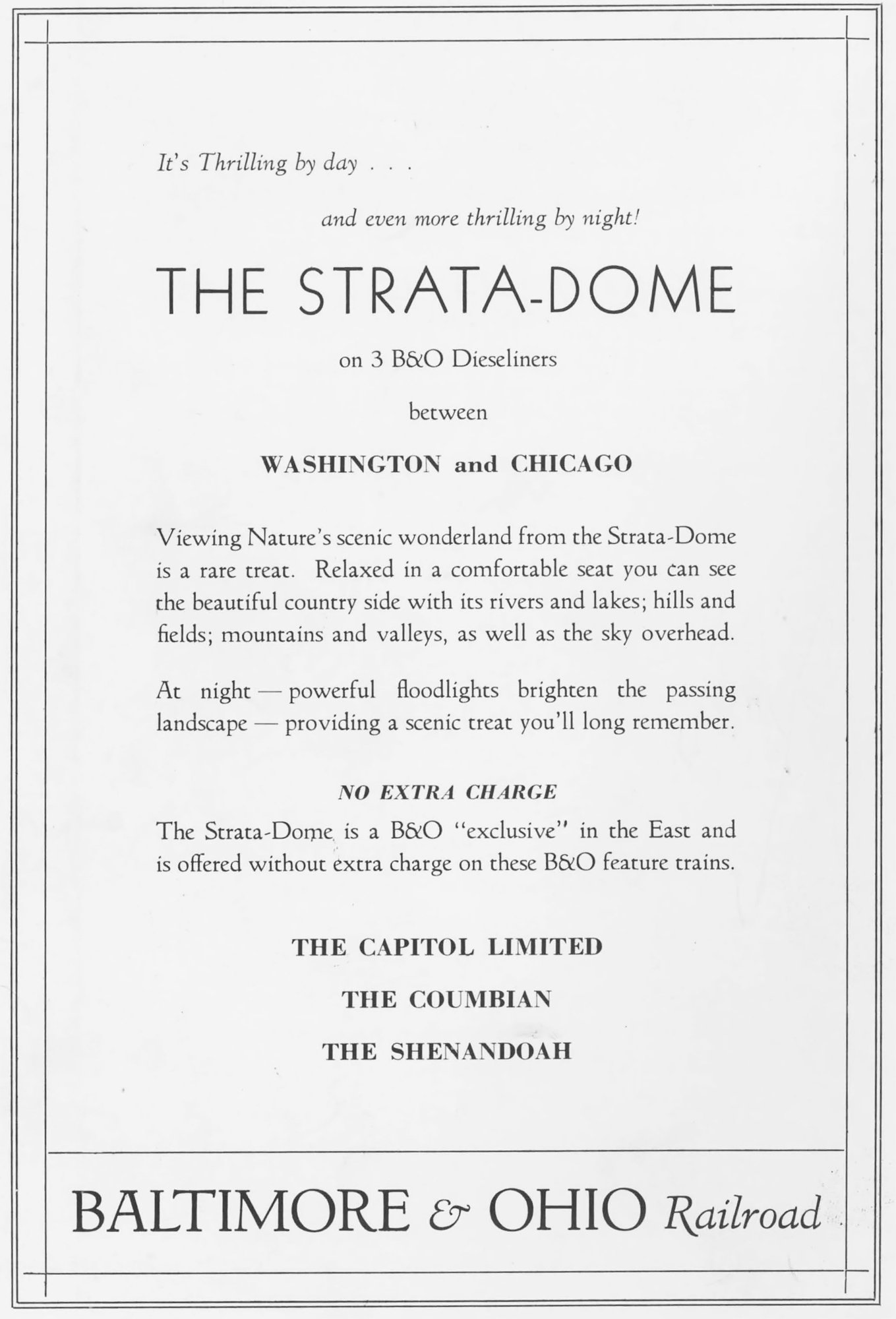Strata-Domes: The B&O Introduces Domes In The East
Published: February 7, 2025
By: Adam Burns
The mid-20th century was a transformative era for rail travel in the United States. This period saw the development and implementation of technologies that reshaped the passenger experience on railroads.
Among the most innovative and luxurious advancements of the time was the Strata-Dome railcar, a marvel of engineering uniquely associated with the Baltimore and Ohio Railroad (B&O).
Strata-Domes were the pioneering dome cars in the Eastern United States, building on the success of the Chicago, Burlington, and Quincy Railroad's "Vista-Domes" in the western region. These cars commenced operations in 1949 and were retired from regular service by 1981, with several units preserved for posterity.

Design and Features
Introduced in 1949, the Strata-Dome railcar was part of the Baltimore and Ohio Railroad's commitment to revitalize its passenger services following World War II. Designed and constructed by the Pullman-Standard, these dome cars were crafted to offer passengers unparalleled views of their journey.
The Strata-Dome's most distinctive feature was its raised, glass-enclosed dome section. This section provided panoramic vistas for passengers, an experience that was unprecedented at the time.
The expansive glass roof spanned the entire width of the car, allowing natural light to flood the interior while offering unobstructed, 360-degree views of the surrounding landscapes.
The interiors of the Strata-Dome railcars were equally focused on comfort and luxury. They featured plush seating and modern amenities, reflecting the B&O's desire to compete with the emerging dominance of automobiles and airplanes by providing a sophisticated and leisurely travel experience.
The dome section often included lounge-style seating, encouraging social interaction and relaxation as passengers marveled at the scenic views.
Strata-Dome Fleet
Pullman-Standard engineered the two pioneering Strata-Dome railcars. The dome section accommodated 24 passengers, while the lower level incorporated two lounges and provided coach seating for 42 individuals.
To meet the reduced clearance requirements on rail lines in the Eastern United States, the dome's height on the Strata-Dome was lowered to 21 inches, compared to the typical 28 inches seen on other dome cars.
These cars were designated with the numbers 5550 and 5551 and were named High Dome and Sky Dome, respectively. Located at the front of each car, the Baltimore and Ohio Railroad (B&O) installed a speedometer, clock, altimeter, and barometer.
In December 1950, the B&O acquired three dome-sleeper cars from the Chesapeake and Ohio Railway (C&O). These vehicles were constructed by the Budd Company for the Chessie, a luxury streamliner planned to travel between Washington, D.C., and Cincinnati, Ohio, which was discontinued prior to commencing service.
Each car featured seating for 24 in the dome, along with the configuration of 3 drawing rooms, 5 roomettes, and 1 bedroom on the lower level. The B&O assigned the numbers 7600–7602 to these cars and bestowed them with the names Moonlight Dome, Starlight Dome, and Sunlight Dome.
In 1952, the B&O augmented the Strata-Domes with floodlights to facilitate the observation of the landscape during nighttime travel.
Historical Use
The original pair of Strata-Domes commenced service with the new Columbian on May 5, 1949, marking the inaugural deployment of dome cars in regular service on the East Coast.
Interestingly, as Kirk Reynolds and Dave Oroszi note in their book "Baltimore & Ohio Railroad," the cars' low clearances did have its drawbacks; notably that for safety reasons guests could not occupy the dome section when operating under the Pennsylvania Railroad's catenary in the Washington, D.C. area.
The Baltimore & Ohio Railroad (B&O) integrated dome-sleepers acquired from the Chesapeake & Ohio Railway (C&O) into the Capitol Limited and Shenandoah lines. Advertisements from that era proclaimed "Strata-Dome" service across all three lines, notwithstanding their diverse origins.
During the 1960s, the B&O occasionally leased the trio of Budd-manufactured dome-sleepers to other railways, including the Atlantic Coast Line Railroad, Canadian National Railway, and Seaboard Coast Line Railroad.
The Atlantic Coast Line implemented these domes on its Florida Special, though they operated exclusively on the Richmond, Virginia to Miami, Florida route due to tunnel clearance restrictions in Washington.
These domes were pioneering in their operation along the Florida corridor. In September 1969, the Seaboard Coast Line—successor to the Atlantic Coast Line—purchased all three domes from the B&O, alongside eight standard sleeping cars, reinstating them on the Florida Special.
The B&O modified the two dome coaches with the addition of a snack bar facility in one of their lower-level lounges. These cars also serviced other B&O routes, such as the Cincinnatian. Notably, the High Dome, emblazoned with "American Railroads 1869–1969" in blue paint, participated in the 1969 Golden Spike Centennial Limited, commemorating the centenary of the first U.S. transcontinental railroad.
Impact On The B&O
The introduction of the Strata-Dome represented a strategic move by the Baltimore and Ohio Railroad to bolster its passenger service offerings.
At a time when railway companies were grappling with declining ridership due to the rise of personal automobile ownership and increased domestic air travel, the Strata-Dome cars served as a unique selling point to attract travelers.
They became a hallmark of the B&O's premier train services, such as the **Capitol Limited**, which operated between Washington, D.C., and Chicago, while showcasing the natural beauty of the Appalachian Mountains and the Midwestern plains.
By elevating the passenger experience, these dome cars played a crucial role in maintaining a competitive edge for the B&O. They appealed particularly to leisure travelers and tourists seeking a unique and scenic travel option.
The Strata-Dome trains were a celebration of the journey itself, rather than just a means to get from point A to point B. Through this innovative approach, the B&O managed to hold its ground during a challenging time for the railway industry.
Final Years
The two original Strata-Domes were featured in the final run of the Capitol Limited on April 30, 1971, preceding its discontinuation at the advent of Amtrak.
Amtrak subsequently acquired the five dome cars, deploying them across various services in the 1970s. The High Dome met its demise in a 1975 accident and was ultimately scrapped in 1980. By October 1981, Amtrak retired its final dome car, the Starlight Dome. Presently, the four remaining dome cars are under private ownership.
Legacy and Historical Significance
While the widespread fusion of domed cars into American railroads began to diminish with the overall decline of long-distance rail travel in the latter half of the 20th century, the Strata-Dome railcars of the Baltimore and Ohio Railroad left a lasting impression.
They epitomized the height of luxury and innovation in passenger rail travel during the post-war era. Beyond their immediate impact on the B&O and its clientele, the Strata-Dome cars have cemented their place in the broader history of American railroading.
The legacy of the Strata-Dome continues today through its influence on modern scenic and tourist rail lines. While few original cars still operate in their intended capacity, the concept of offering passengers an immersive and enjoyable travel experience lives on.
Heritage railroads and scenic train operators have embraced the dome car concept, catering primarily to tourists eager to experience the nostalgic charm of train travel.
In conclusion, the Strata-Dome stands as an emblem of a bygone era, representing the ingenuity and elegance of mid-20th-century American railroading.
Its introduction marked a pinnacle in enhancing passenger comfort and scenic appreciation, filling a unique niche during a transformative time for the rail industry.
Through its innovative design, the Strata-Dome contributed to the legacy of the Baltimore and Ohio Railroad and remains a cherished chapter in the rich tapestry of rail travel history.
Recent Articles
-
Waterbury Union Station: An Historical Tapestry
Feb 08, 25 12:30 AM
Waterbury Union Station is the city's historic train station that originally opened in 1909. It is best known for its massive 240-foot clock tower. -
Portland Union Station (Maine): Serving Northern New England
Feb 08, 25 12:30 AM
Portland Union Station was the city's prominent passenger terminal serving the Boston & Maine and Maine Central from 1880-1960. It was demolished in 1961. -
Louisville Union Station: A Rich Legacy
Feb 08, 25 12:02 AM
Louisville Union Station is the city's historic passenger terminal serving the Louisville & Nashville, Monon, and PRR. Today, it serves as offices for Transit Authority of River City.





